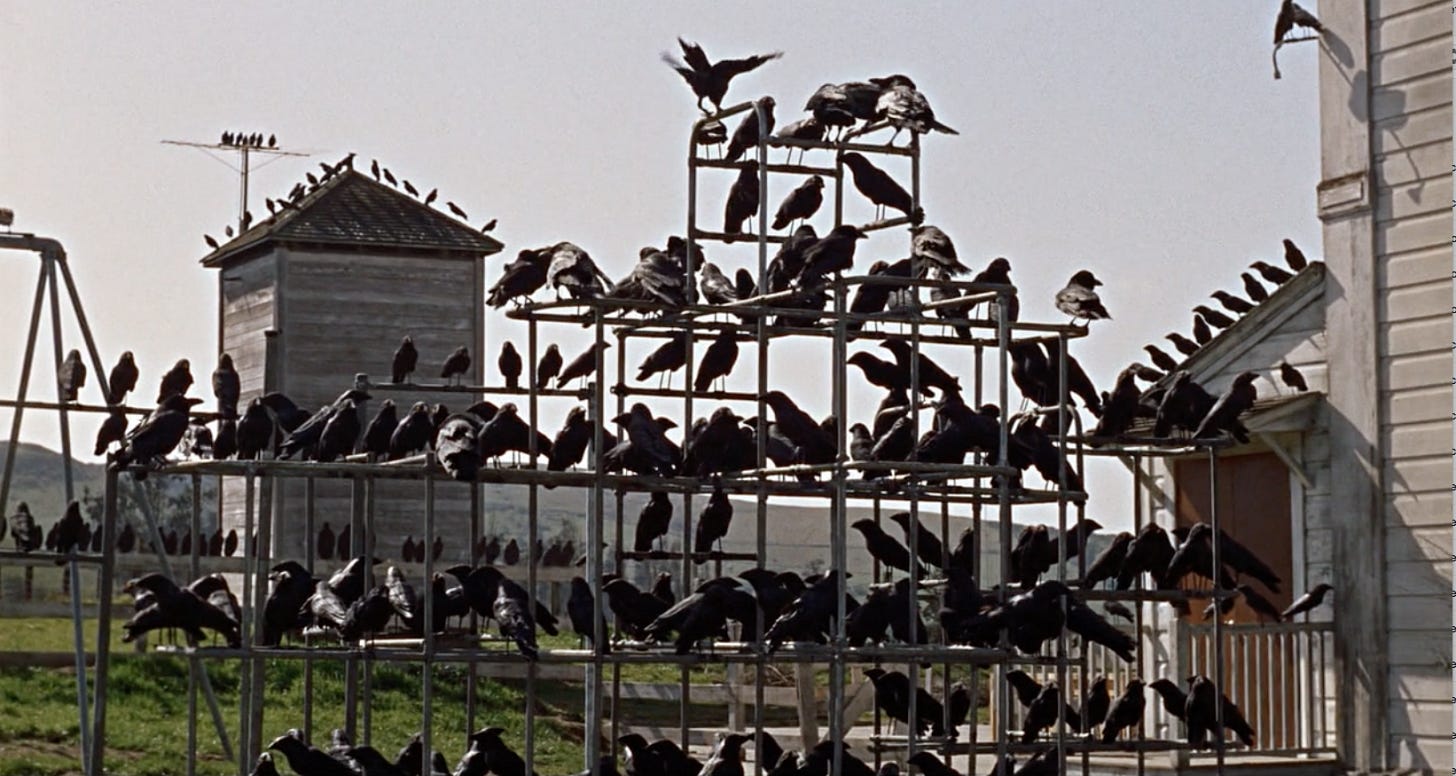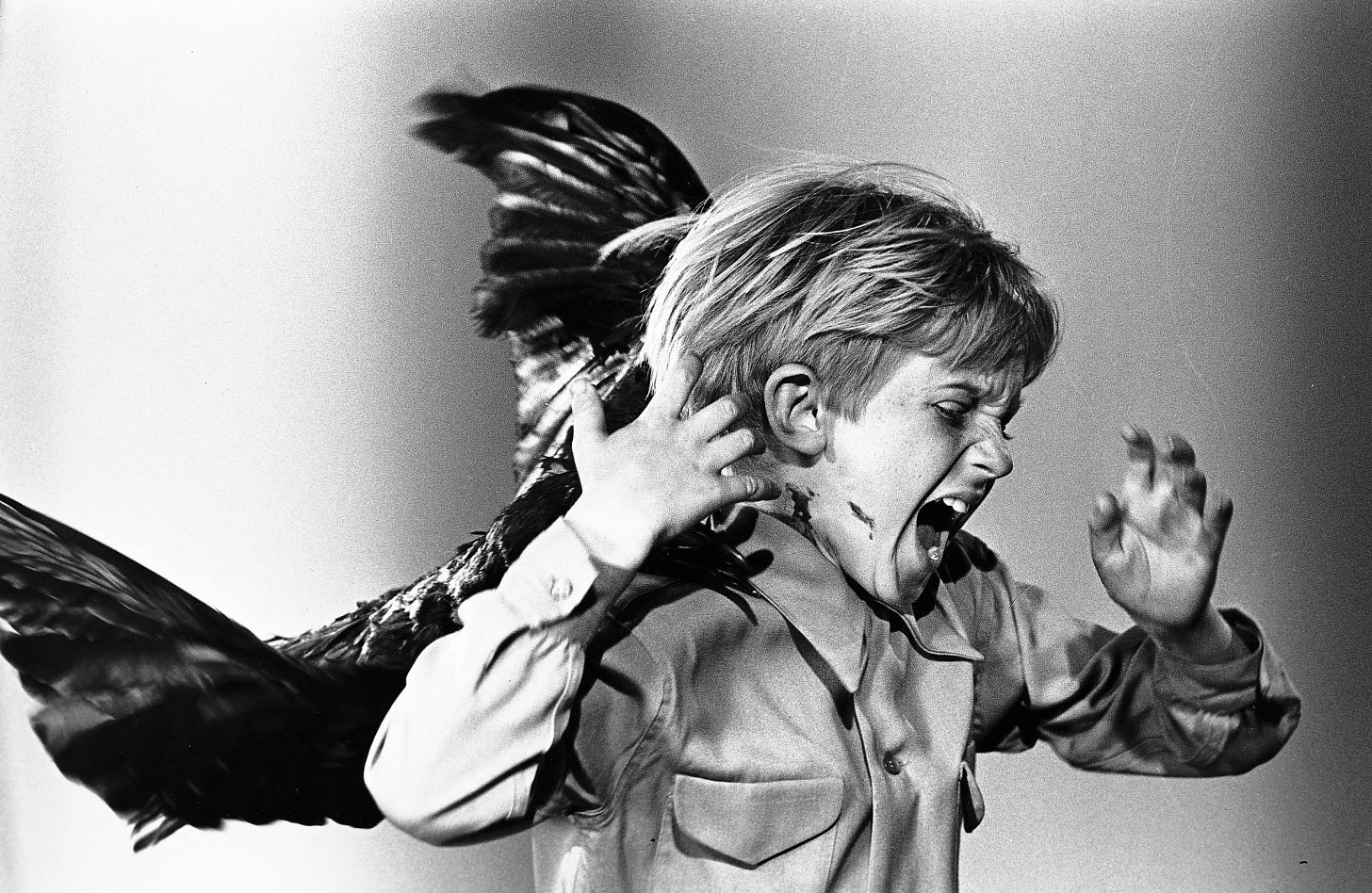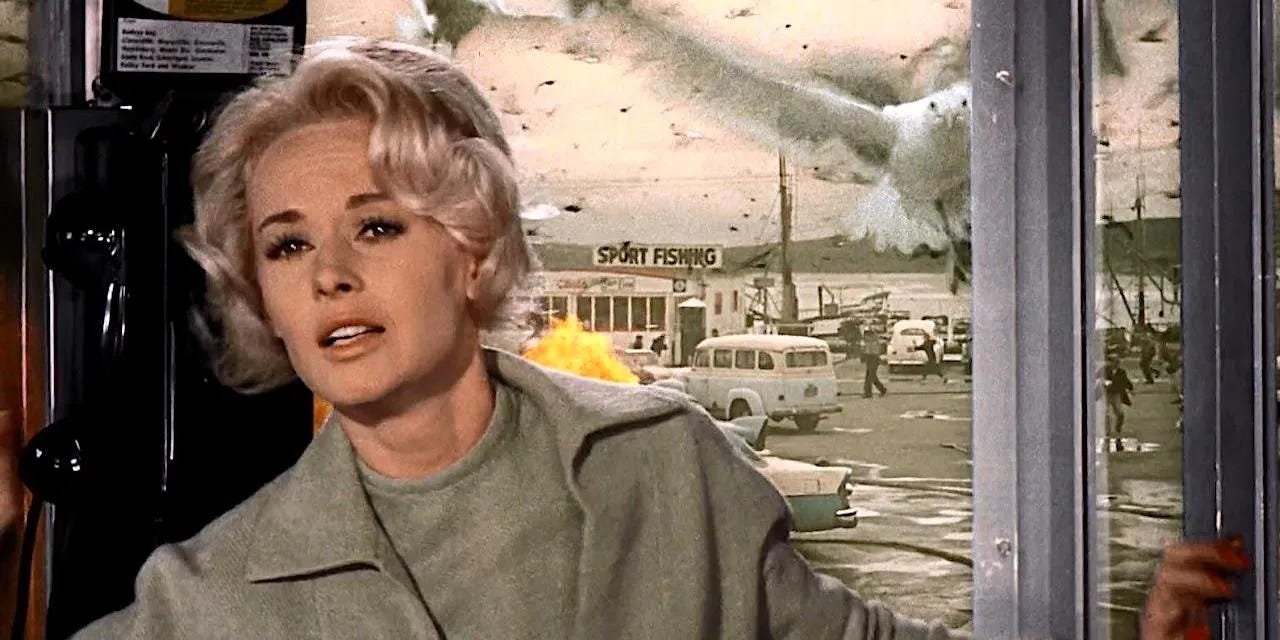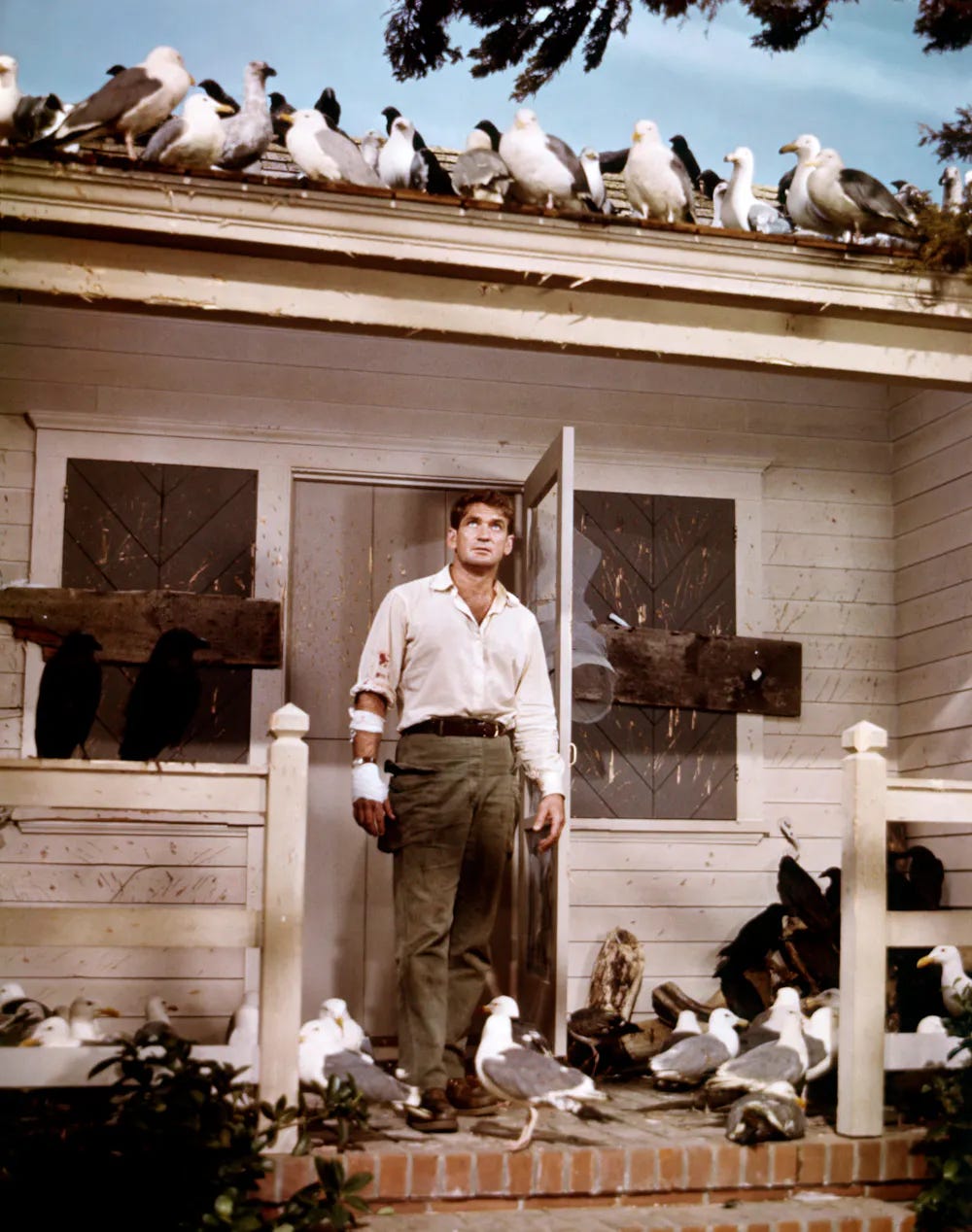I haven’t always loved horror.
I remember a time, well before sitting down to watch a horror movie became a source of comfort and inspiration, when the mere idea of these movies used to scare the shit out of me. I experienced night terrors extrapolated from fragments of X-Files glimpsed from the top of my stairs, and can still remember sleepless nights after my mom once casually described the plot of Poltergeist to me in our kitchen. I hadn’t even seen Poltergeist, and it still held power over me, kept me awake, eyes searching the dark, my imagination stamping monstrous shapes and horrid faces on the familiar canvas of my bedroom walls.
I’m not sure how old I was when my family rented Alfred Hitchcock’s The Birds, but I never forgot certain images from it: crows gathering on the playground; seagulls blotting out the blue sky over a children’s birthday party; a farmer staring straight into the camera lens (straight at me) through bloody spaces where his eyes should have been.
It was probably somewhere around the attack on the schoolchildren that I left the room, and I never returned to finish The Birds until this year, following a trip up to Bodega Bay, where the film is set (only about an hour or so from where I now live). Bodega Bay seems proud of its legacy as the backdrop of this enduring story of avian mayhem. And there was a certain charm to the place that made the idea of The Birds seem more whimsical than terrifying. So, I decided it was probably time to finish what I started all those years ago.
Two things surprised me:
The first was how a movie with such a ridiculous premise, one that is so easy to mock and seems ripe for parody, still delivers a palpable feeling of uncanny dread. And second, what a near perfect representation this film is of certain feelings I’ve had in the year since I arrived in northern California.

I recently began having anxiety attacks for the first time in nearly fifteen years. My struggles with anxiety and depression were a more immediate presence in my life when I was young, but with time and support and insight, their looming presence has lessened. The circumstances and pressures that caused these forces to return with such immediacy into my life is not the point of this post. What I want to get at here is something that is known by many fans of horror films, but might seem strange to those who steer clear of them altogether, and ask questions like “why the hell would you decide to scare yourself when life is frightening enough already?”
It’s a good question, and one that I think takes more than one person to adequately answer, but for my part - at this moment in my life when panic and fear seem closer at hand, and my ability to control them feels too often outmatched - it can be truly comforting to recognize my emotional and psycholgical experiences within a piece of art.
As someone familiar with anxiety as both a steady presence and a sudden consuming one, I find it calming to watch those same sensations unfold on a screen in the elevated scenarios of genre fiction. I can turn to psychology and therapy and neuroscience to better understand these feelings, but horror, when done well (and hell even when done charmingly poorly), offers scale models of these experiences, safe and even entertaining ways to engage with them, and in so doing, lessen the threat they pose.
There are many layers to the appeal of horror, but to see certain heightened feelings reflected back at you is certainly one of them. They can tell you, now and then and in indirect and fantastic and even silly terms, that you are not the only one who feels this way.
The central character in The Birds is Melanie, played by Tippi Hedren in her film debut, who comes to Bodega Bay as an outsider, and not just within this tight-knit community. As the socialite daughter of a newspaper editor, she is a person whose every move is publicly scrutinized. She feels that there are eyes on her at all times, that she is judged and weighed by everyone she meets, and even those she doesn’t. She is both seen by all and yet, as we get to know her throughout The Birds’ character-focused first act, painfully lonely.
Even in the film’s most chaotic and quite literally explosive moments, Melanie finds herself in isolation. While mayhem swarms around her on Main Street, she is trapped inside of a glass phone booth. The world around her is on fire, and she can see it all, but she is alone, unable to move or to save anyone let alone herself. She is surrounded yet apart. I can think of few moments in movie history that simultaneously combine the fear of extrinsic chaos and internal helplessness so effectively…and if it is a little on the nose, a little too perfect in its metaphorical construction, all the better. Subtlety doesn’t apply when panic is at the wheel, and the overwhelming portrayal of that here screams with resonance.
Right after this sequence ends, the question is raised as to whether Melanie herself is the cause of this strange attack, when a diner at a local restaurant points out that nothing like this ever happened before she arrived in town. Melanie slaps this woman (a moment of great catharsis after her powerlessness) but we can tell she is rattled by the question the woman has raised. Is it this place that is afflicted, or did she bring this disaster with her? It’s a question that is never answered or raised again, but one that haunts the remainder of the film, and contributes to the unraveling of its protagonist. We know that self-blaming often quickly follows moments of high anxiety, and the question Melanie grapples with is one that is familiar to so many: is the world wrong, or am I?
If Tippi Hedren’s Melanie represents the descent into anxiety, then Rod Taylor’s Mitch is the opposite. He remains poised and explicitly alpha-masculine throughout, and frankly, I can’t relate. But his presence and his stoicism is important to the story. A furrow to his brow is about as much emotion as he shows, even while his home and his family are under direct attack. He becomes little more than a strong, well-sunned shoulder for Melanie to cry on. This is not a criticism of Taylor’s performance, or an indictment of his character’s construction. He is a necessary foil, and his experience of this uncanny upheaval feels just as true as hers.
At the close of the film he walks freely among the birds—who have just moments ago ravaged Melanie into a bloody, catatonic state (there is plenty of behind-the-scenes darkness to discuss, particularly around this sequence’s filming, but that’s been well covered elsewhere). Gulls and crows alike are gathered en masse outside of Mitch’s home, but seem—for the moment—at rest; entirely disinterested in Mitch as he moves through them, cautious but unharmed. When, in the film’s final moments, Mitch helps Melanie out of the house, propping her up despite her cries of protest (a truly unsettling “no”) his concern seems to be less for the birds than for this person beside him.
Watching Mitch is how it feels as someone with anxiety watching others walk through life free of anxiety (or who appear that way). Mitch is the person who remains largely unaffected by the same forces that cause others to break down.
He makes it look easy.
I freely admit I’m projecting here. Throwing my own preoccupations right at a movie that is, when all is said and done, really just about murderous birds. And I’m aware of how silly all of this might sound, if the film did not feel so ripe for individual interpretation. Whereas other Hitchock films—Psycho, for one—use the final act to spell everything out, to articulate intent and even directly diagnose the nature and cause of the threat…The Birds leaves the question of why entirely out of the equation. That frustrates some, but for me elevates the film’s power.
Perhaps my favorite idea in this entire film is that the attacks are not constant but intermittent. They come in waves, with moments of quiet, even peacefulness in between. Birds - reliable cultural symbols for peace and freedom - are the central threat, but are not relentless in their onslaught. They perch, and watch, and loom. The moments when we see them doing this are, for me, the most frightening. Their presence is a reminder that another attack might come at any moment.
Most any film about a threat or an enemy - be it monstrous or alien or microscopic or supernatural - becomes all about one question: how do we beat it? Ultimately, the question at the heart of The Birds is not how to cure or defeat or correct this threat, but how to endure it. And that seems to me a much more interesting, and true to life, sort of struggle.
I don’t beleive Hitchcock had anxiety explicitly in mind when he made The Birds, nor did Daphne du Maurier when she wrote the story that inspired it. But I do think that Hitchcock was a filmmaker whose genius was being tuned in to the experience of his audience. His awareness of the ways he could provoke them, thrill them, to make them laugh, hold them in tension and suspense, and keep them engaged while in the theater and, as it turns out, for generations. And I don’t think it was accident or negligence that led him to deny us an answer to the why of it all. You might well see this same movie and key into themes of humankind’s frailty in the face of nature. You might think about rage rather than panic. You might think about small towns versus big cities. You might think of mothers and sons and daughters. You might just laugh and find it purely silly. Those crazy birds, at it again.
And all of that is good, and welcome. I’m of the mind that intention is only one small part of what defines a work of art, and film - maybe horror in particular - feels incredibly welcoming of the viewer.
After all this time, I’m glad I came back to finish this movie at this moment in my life. A movie I once saw as a threat, but that I can now greet as a strange kind of friend.








I need to watch this one again. Critics didn't think it was Hitchcock's best work. It was definitely outside his typical style in a few ways, so maybe that was part of it. I've read in a few places that the story was inspired by a real event: some years earlier in the coastal town of Santa Cruz where thousands of sea birds were poisoned by a natural occurring toxin in an bloom of algae ("red tide"). The birds flew into town where they crashed into buildings, cars, people. It must have been quite unsettling. However fortunately no pretty blonds were pecked to death.
There is some strange synchronicity in the universe. I stepped outside from a busy cafe I was dragged to by family - the noise and people too much for me and triggering my anxiety - sipped my coffee and checked my emails to find this post pop up. Ive always had an affinity with this movie, the retro-ness of it brought many laughs among my friends: “quick! Cover your eyes with your pants” was a joke cry we made seeing seagulls gathering. I am, in fact also wearing extremely high waisted pants on this particular day. This article was a joy to read and brought me much comfort at a fitting time. Thank you for writing and sharing this story - it’s ripple effect is delightful :)